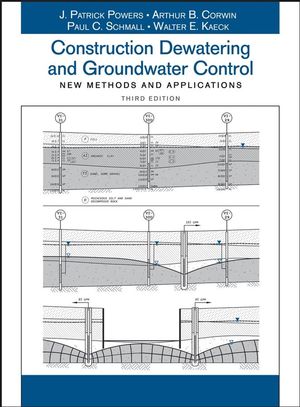Construction Dewatering and Groundwater Control: New Methods and Applications, 3rd EditionISBN: 978-0-471-47943-7
Hardcover
656 pages
May 2007
 |
||||||
Groundwater in Construction.
1.1 Groundwater in the Hydrologic Cycle.
1.2 Origins of Dewatering.
1.3 Development of Modern Dewatering Technology.
THE GEOLOGY OF SOILS.
2.1 Geologic Time Frame.
2.2 Formation of Soils.
2.3 Mineral Composition of Soils.
2.4 Rivers.
2.5 Lakes.
2.6 Estuaries.
2.7 Beaches.
2.8 Wind Deposits.
2.9 Glaciers-The Pleistocene Epoch.
2.10 Rock.
2.11 Limestone and Coral.
2.12 Tectonic Movements.
2.13 Man-Made Ground.
Soils and Water.
3.1 Soil Structure.
3.2 Gradation of Soils.
3.3 Porosity, Void Ratio and Water Content.
3.4 Relative Density, Specific Gravity, and Unit Weight.
3.5 Capillarity and Unsaturated Flow.
3.6 Specific Yield and Specific Retention.
3.7 Hydraulic Conductivity.
3.8 Plasticity and Cohesion of Silts and Clays .
3.9 Unified Soil Classification System (ASTM D-2487).
3.10 Soil Descriptions.
3.11 Visual and Manual Classification of Soils.
3.12 Seepage Forces and Soil Stress.
3.13 Gravity Drainage of Granular Soils.
3.14 Drainage of Silts and Clays: Pore Pressure Control.
3.15 Settlement as a Result of Dewatering.
3.16 Preconsolidation.
3.17 Other Side Effects of Dewatering.
Hydrology of The Ideal Aquifer.
4.1 Definition of the Ideal Aquifer.
4.2 Transmissivity T.
4.3 Storage Coefficient Cs and Specific Yield .
4.4 Pumping from a Confined Aquifer.
4.5 Recovery Calculations.
4.6 The Unconfined or Water Table Aquifer.
Characteristics of Natural Aquifers.
5.1 Anisotropy: Stratified Soils.
5.2 Horizontal Variability.
5.3 Recharge Boundaries: Radius of Influence R0.
5.4 Barrier Boundaries.
5.5 Delayed Release from Storage.
Dewatering Design Using Analytical Methods.
6.1 Radial Flow to a Well in a Confined Aquifer.
6.2 Radial Flow to a Well in a Water Table Aquifer.
6.3 Radial Flow to a Well in a Mixed Aquifer.
6.4 Flow to a Drainage Trench from a Line Source.
6.5 The System as a Well: Equivalent Radius rs.
6.6 Radius of Influence Ro.
6.7 Hydraulic Conductivity K and Transmissivity T.
6.8 Initial Head H and Final Head h.
6.9 Partial Penetration.
6.10 Storage Depletion.
6.11 Specific Capacity of the Aquifer.
6.12 Cumulative Drawdowns or Superposition.
6.13 Capacity of the Well Qw.
6.14 Flow Net Analysis and the Method of Fragments .
6.15 Concentric Dewatering Systems.
6.16 Vertical Flow.
6.17 Gravel Tremie.
Groundwater Modeling using Numerical Methods.
7.1 Models in Dewatering Practice.
7.2 When to Consider a Numerical Model .
7.3 Principal Steps in Model Design and Application.
7.4 The Conceptual Model: Defining the Problem to be Modeled .
7.5 Selecting the Program.
7.6 Introduction to MODFLOW.
7.7 Verification.
7.8 Calibration.
7.9 Prediction and Parametric Analyses.
7.10 Some Practical Modeling Problems.
7.11 2-D Model: Well System in a Water Table Aquifer.
7.12 Calibrating the Model .
7.13 3-D Model: Partial Penetration.
7.14 3-D Model: Vertical Flow.
7.15 3-D Model: Transient Analysis of a Progressive Trench Excavation.
7.16 3-D Model: Feasibility of Tunneling in a Stratified Aquifer with Proximate Recharge.
Monitoring.
8.1 Subsurface Information.
8.2 Ordinary Piezometers and True Piezometers.
8.3 Piezometer Construction.
8.4 Verification of Piezometer Performance.
8.5 Obtaining Data from Piezometers.
8.6 Pore Pressure Piezometers in Fine-grained Soils.
8.7 Direct Push Technologies for Piezometer Installation.
Pumping Tests.
9.1 When a Pumping test Is Advisable.
9.2 Planning the Test.
9.3 Design of the Pumping Well.
9.4 Piezometer Array.
9.5 Duration of Pumpdown and Recovery.
9.6 Pumping Rate.
9.7 Monitoring the Test .
9.8 Analysis of Pumping Test Data.
9.9 Tidal Corrections.
9.10 Well Loss.
9.11 Step Drawdown Tests.
9.12 Testing of Low Yield Wells .
9.13 Delayed Storage Release: Boulton Analysis.
Surface Hydrology.
10.1 Lakes and Reservoirs.
10.2 Bays and Ocean Beaches



